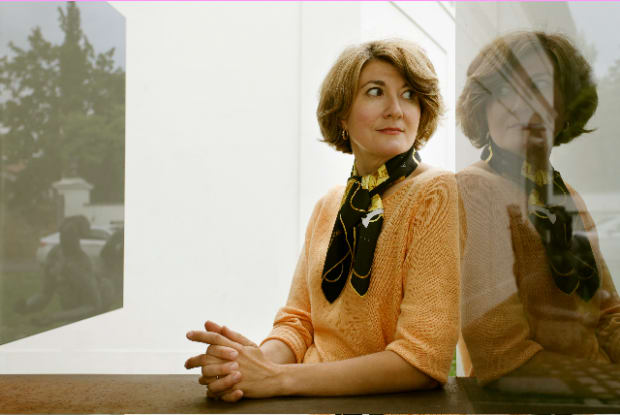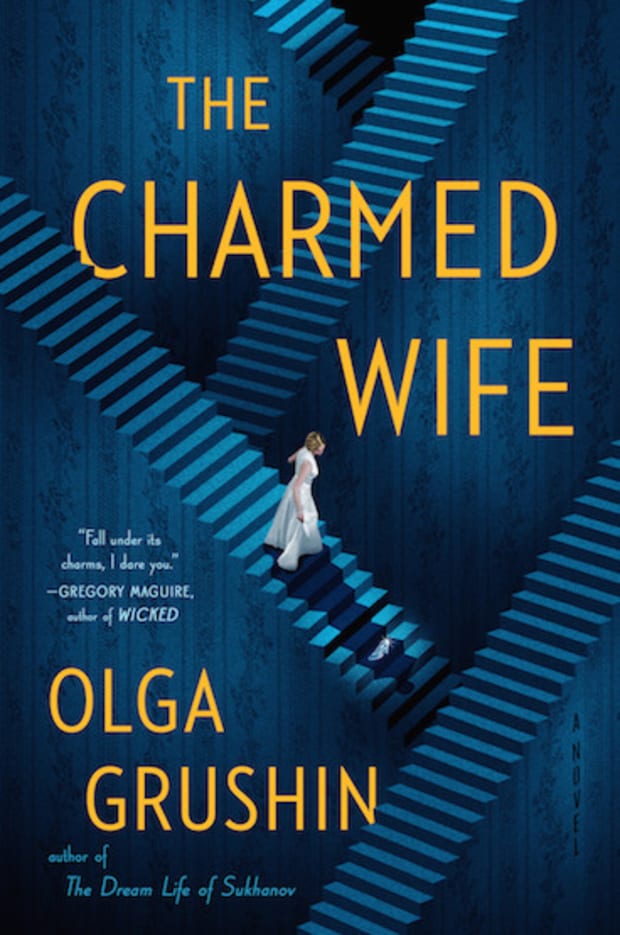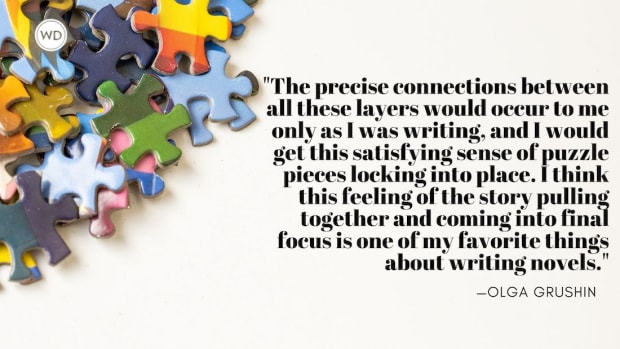Award-winning author Olga Grushin discusses what it meant to wade into a new genre and how she put her spin on the fairy tale retelling.
Olga Grushin was born in Moscow, spent her childhood in Prague, and moved to the United States at eighteen, becoming the first Russian citizen to receive an American college degree. She is the author of three previous novels. Her debut, The Dream Life of Sukhanov, won the New York Public Library Young Lions Fiction Award, earned her a place on Granta’s once-a-decade Best Young American Novelists list, and was one of the New York Times’ Notable Books of the Year. Both it and The Line were among The Washington Post’s Ten Best Books of the Year, and Forty Rooms was named a Kirkus Reviews Best Fiction of the Year. Grushin has published short stories and nonfiction in the New York Times, The Wall Street Journal, Vogue, Partisan Review, and elsewhere. She writes in English, and her work has been translated into sixteen languages. She lives outside Washington, D.C., with her two children.

In this post, Grushin discusses what it meant to wade into a new genre, how she put her spin on the fairy tale retelling, and more!
****

Name: Olga Grushin
Literary agent: Warren Frazier at John Hawkins & Associates
Title: The Charmed Wife
Publisher: G.P. Putnam’s Sons
Release date: January 12, 2021
Genre: Literary, modern fantasy, fairy-tale retelling
Previous titles: The Dream Life of Sukhanov (2006); The Line (2010); Forty Rooms (2016)
Elevator pitch for the book: After thirteen years of marriage, Cinderella wants her Prince Charming dead. This subversive exploration of our romantic expectations is set in a world where time and place, fantasy and reality interweave in surprising ways—and nothing is quite what it seems.

IndieBound | Bookshop | Amazon
[WD uses affiliate links.]
What prompted you to write this book?
I loved fairy tales as a child—the more traditional, the better, all those princes, princesses, and happy couplings. Yet when I started reading them to my own daughter, she liked stories with tricksters and talking animals well enough, but she absolutely loathed any mention of princesses. “Stories with princesses are so boring,” she said. “They are really all the same story.”
At the same time, it so happened, I was going through a divorce. It was this confluence of my seven-year-old’s reaction and the end of my marriage that prompted me to take a closer look at the happily-ever-after tales we tell ourselves. Eventually, I knew that I wanted to write a book that would start as a predictable two-dimensional fantasy, with pastel-colored princesses, singing teapots, and waltzing mice, but would then grow in surprising, modern directions and arrive at a very different narrative in the end.
(A Word About Writing Princesses and Fairy Tales)
How long did it take to go from idea to publication?
This is my fourth novel, and by now my overall approach has become more or less streamlined. It takes three to four years from the first glimmering of the idea to the finished volume that smells so delightfully of fresh ink: a year of gestation and research (or, if no actual research is required, reading “around the subject”); a year of intense daily writing to create the first draft; and one to two years devoted to revisions and the actual publishing process.
I always expect my initial idea to undergo countless changes in the planning stage—that is really what this stage is for. With every new novel, I start a thick notebook where, for months, I jot down themes, plot possibilities, personality sketches, useful facts, and so on. Then one day—and this day always comes without warning—I wake up and feel that I have accumulated enough material, so I read through the entire notebook and, out of the primordial flux of semi-thoughts and proto-characters, create an outline and begin to write. My outlines are never ironclad, though, but have plenty of breathing room to allow for organic changes that will inevitably happen in the actual writing stage.
With The Charmed Wife, I knew from the beginning that the figure of Cinderella would be at the heart of the story, and early on, I decided to weave in other familiar narratives as well, so Sleeping Beauty, Rapunzel, Bluebeard, and many others began to find their way into my outline. Later still, the mouse theme emerged as its own subplot: I felt that I needed a sort of “downstairs” counterbalance of mouse wars and revolutions to the “upstairs” romance-obsessed life of the princess to cast her arc in a different light. But often, the precise connections between all these layers would occur to me only as I was writing, and I would get this satisfying sense of puzzle pieces locking into place. I think this feeling of the story pulling together and coming into final focus is one of my favorite things about writing novels.
Were there any surprises or learning moments in the publishing process for this title?
I have published all my novels with the same publishing house, Putnam, but the editor who guided my first three books into life, the wonderful Marian Wood, retired a little while ago, and she passed away earlier this year—such a great loss in this year of losses. For this book, then, I have worked with an entirely new team. They are young, enthusiastic, and full of fresh ideas, and I am learning unexpected things. For example, I was always rather old-fashioned when it came to social media, but, at the gentle promptings of my new editor, Gabriella Mongelli, I took a timorous step into the realm of Twitter. I had believed myself intrinsically unsuited for it—the very thought of 280 characters seemed anathema to someone raised on Tolstoy’s War and Peace—yet now I am enjoying it thoroughly. This just goes to show that it is never too late to leave your comfort zone.
Were there any surprises in the writing process for this book?
This entire book was really a surprise. I grew up in Moscow, reading nineteenth-century Russian classics, and when, still as a teenager, I declared I would be a writer, I imagined myself writing only “serious,” weighty books. In the early years of my career, I did not see fantasy as a respectable genre at all. But if I have learned anything in my subsequent decades of reading and writing, it is that genre divisions are arbitrary and literature is literature wherever it is found. This book was a great departure from my earlier novels (mostly set in Soviet Russia and dealing with totalitarian regimes and oppressed artists, among other things), and it was tremendous fun to write—the most fun, in truth, I had with any novel. I loved stepping out into the no man’s land between genres, playing with fantasy and reality, bending conventions, breaking my own past rules. I had this constant sense of adventure while I was working on it. “Can I really do this? Can I really go there, say that? Yes, I can—because why not, and who is going to stop me?”
What do you hope readers will get out of your book?
This is not at all a traditional fairy-tale retelling, and readers who pick it up looking for a child-friendly Disney-style fantasy may find it quite unsettling. But if they approach it with open minds and few preconceived notions, I hope they will be entertained. I wanted to write something whimsical, something fun (even if the fun is often dark). At the same time, even talking mice can be thought-provoking. If, upon finishing the book, my readers feel they have gained a surprising new perspective on traditional stories, I will be very happy.

If you could share one piece of advice with other authors, what would it be?
So much excellent advice is already out there. Live a full life. Read, read as much as you can, across all genres. Approach your writing not as sporadic visits from some flighty muse but as a daily grind. Budget your time. One thing I would stress especially: for a woman writer with a family, it is absolutely essential to carve out not only a “room of one’s own” in your home but also a “room of one’s own” in your mind—a place where you can go and forget, for a stretch, about children’s homework, dinner, and laundry, and devote yourself fully to the world you are creating. Without this intense concentration, without this full immersion, book-length projects cannot be sustained. Teach people who share your life to respect your work from day one.
Be First to Comment